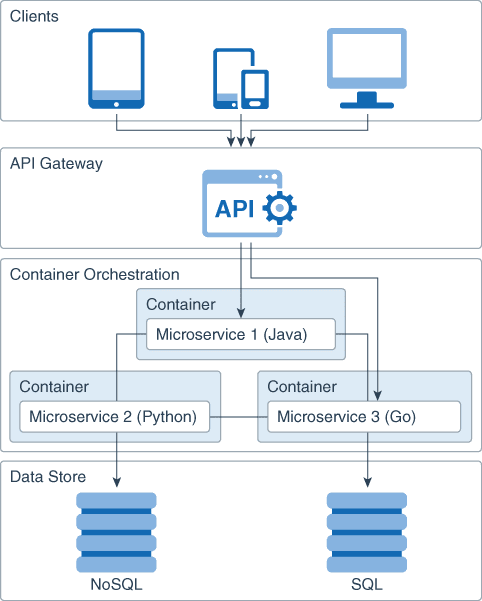Contents
Introduction
We’ve been developing software systems and applications for quite some time, and we’re getting better at it every year. Over the years, several technologies, architectural patterns, and standard operating procedures have emerged and matured. Over time, and for various reasons, many software programs inevitably grow into big, complicated monoliths. In a monolithic system, system components are developed and bundled as a single unit. Even if a single component of the system is to be modified, it will necessitate the redeployment of the entire system. The complexity of developing, deploying, and maintaining monoliths hinders the competitiveness and agility of development teams.
Developing comprehensive applications can be challenging due to the interconnected and interdependent nature of a self-contained system. Affected systems also make it difficult to make essential improvements, embrace new technology stacks, and update and upgrade ships. Furthermore, we should not underestimate the difficulty of paying off the technical debt that monoliths accumulate, as modifying even a small portion of monolith code can have a domino effect that brings down a live application.
When it comes to overcoming the problems inherent in huge, complicated software applications known as “monoliths,” Service Oriented Architecture (SOA) was among the first architectural patterns to address the issue by decomposing a large, complex software application into smaller, independent pieces called “services. An Enterprise Service Bus (ESB) is used for all of these services to communicate with one another. Due to their shared database, these smaller systems or services behave more like large monoliths. Additionally, ESB becomes the single point of failure when more and more service-aware logic is introduced to it.
Successful software development strategies require a cohesive yet granular approach, and here is where the microservice architecture steps in as the next step in the domain. Over the past few years, a new term, “Microservice Architecture,” has emerged to define a specific approach to developing software systems as collections of independently deployable services. There is no agreed-upon definition of this architectural approach, but its hallmarks include a focus on the organization’s resources around business capabilities, the use of automated deployment, the incorporation of intelligence into endpoints, and the decentralization of language and data management. Microservices have grown as architectural patterns in the following areas: domain-driven design, platform, and infrastructure automation, continuous delivery, scalable systems, polyglot programming, and persistence. In this blog, we look into what microservices architecture really means and how it works, and its benefits.
What Is Microservices Architecture?
Microservices architecture, or microservices for short, is an architectural approach to designing and building software where a single application is composed of many loosely coupled and small, independently deployable components or services that communicate over well-defined APIs, with each part having its own realm of responsibility. Each service has its own codebase, inclusive of the database and data management model, which may be controlled by a small development team.
A microservices-based application can call on numerous internal microservices to compose its answer to a single user request. Applications using microservices architectures are easier to scale and can be developed more quickly, which enables innovation and speeds up the time it takes to bring new features to the market. As opposed to monolithic architecture-based systems that take months or years to complete, microservices can be used to build scalable, tested software solutions that can be continuously provided in small bursts of time.
Understanding Monolithic Architectural Design
Microservices operate as stateless processes and adhere to the share-nothing model. The application is simpler to scale and maintain with this approach. Let’s look at the microservices architecture layer.
The first layer is the client layer, i.e., the digital devices. For all client requests to microservices, the API layer, which is the second layer, serves as the point of entry. The API layer also makes it possible for the microservices to communicate with one another using HTTP, gRPC, and TCP/UDP.
The third layer is container orchestration, which encapsulates all the microservices within a container. This logic layer minimizes reliance on other microservices by concentrating on a particular business task. This layer could be developed in a separate language for each microservices.
The data store layer is the fourth layer in the stack that offers a persistence mechanism, such as a database storage engine, log files, and so forth.
How Microservice Architecture Works
The concept of separation of concerns serves as the foundation for the microservices architecture. This means that each microservices should be independent and have a single task. This enables autonomous development, deployment, and scaling of each service relative to the others. The concept of “dumb pipes” and “smart endpoints” underpins these microservices. This means that each microservices should expose a basic interface that other services can use. After that, the microservices should process the request and return the response. This allows each microservices to be created independently and makes scaling and deploying services easier. There is no single correct approach to designing microservices because they are a concept rather than a specific technology. However, as illustrated below, there are a few basic patterns and technologies that are frequently used.
Containers: Containers, which are the tools and methods needed to construct and organize microservices, go hand in hand with microservices. It is a software bundle that includes configuration, code, system tools, runtime, and libraries. Containers segregate software systems that run in the same environment, allowing for concurrent processes on various microservices.
Dockers: Dockers are containerization technologies that help manage containers, easing the process of developing scalable and manageable applications. Docker microservices enable faster startup, faster deployment, more efficient use of computer resources, easier container management, scalability, and more support for many operating systems.
Service discovery: Service discovery allows microservices to find and communicate with one another. This enables services to be registered and dynamically located.
API gateway: An API gateway is a centralized point of entry for all queries into a microservices architecture. The API gateway sends a request to the right service and can additionally handle duties like authentication and rate limitation.
Event sourcing: Event sourcing is a pattern in which data is stored and retrieved via events. This enables the storage of an exhaustive history of all occurrences, which can be used to reconstruct the state of an application at any given time.
When Should You Use Microservice Architecture?
Let’s examine some potential situations when you might think about choosing a microservice architecture:
Consider the microservices architecture for developing a new application that requires high levels of scalability, flexibility, and reliability. Each component can be created using a different programming language and framework.
Consider migrating to microservices from a monolithic application if the application’s functionality can be divided into focused services with limited scope. In cases where monolithic applications can’t be migrated to the microservices architecture, then consider
creating only the new functionality as microservices.
When there is a business need to make a change to the functionality or independently deploy new functionality with no downtime
When there is a need to resolve any interdependency issues among services that affect the availability of applications during a service redeployment.
When there is a need to rewrite legacy applications in new languages as well as update the technology stack to match the demands of modern business.
Scenarios that demand a service provider to offer computing resources and infrastructure management to its customers as needed. For example, price calculation services, forecasting services, prediction services, etc.
When a client-side web app with data coming from multiple channels or different sources requires dynamic back-end services.
When there is a need to isolate specific data and data processing in order to comply with specific data security and compliance standards through data partitioning
Benefits of Microservices
Agility
Microservices are agile because they are deployed independently of one another. It is simpler to manage microservices, fix bugs, and add new features. Because the entire application does not need to be redeployed to update one service, the process is much smoother.
Scalability
Microservices enable dynamic horizontal scaling across service boundaries because they are distributed by design and can be deployed in clusters. New instances of the microservice can be quickly deployed to the coordinating cluster to help ease the load if a microservice reaches its load limit. Microservices are not only easier to scale but also faster and less expensive.
Frequent Releases
The frequent and quicker release cycles of microservices are one of their main benefits. Microservices are a fundamental component of continuous integration and continuous delivery (CI/CD), which enables teams to test out new features and roll back if necessary. This speeds up the time it takes to market new features and makes updating code simpler.
Reduced Downtime via Fault Isolation
A microservices architecture allows each service to operate independently of the others, ensuring that even if one service experiences a problem, the rest of the application continues to function normally. The fault is isolated and does not result in cascading failures that would cause the entire application to crash. The downtime is decreased because the services are built to handle failure effectively.
Easy Management with Smaller Codebases
Microservices don’t have a shared codebase, and their data is stored independently, reducing dependencies and ensuring that changes to one service do not affect others. As a result, debugging and code expansion is made simpler because you do not need to comprehend the entire codebase.
Flexible Technology Stack and Programming Language Selection
In a microservice architecture approach, each team can choose the technologies and programming languages that are most appropriate for their service. Teams are more adaptable when they use a variety of technology stacks, and this also lets them choose the languages that best suit their unique needs.
Reusable Code
Software that has been broken down into manageable, well-defined modules allows teams to use its functions in a variety of ways. A service written for a specific purpose can serve as the foundation for another feature. As a result, developers can add new features to an application without having to start from scratch with their code.
Top Tech Giants Using Microservices
Although you probably use microservices-based applications every day, you can’t tell from the outside if they were created using a monolithic architecture or not. Microservices are becoming a popular choice among developers as software systems get more complicated and feature-rich. The last thing you want is for your application on which millions of users rely, to fail because of a single change in the code.
Netflix
Some of the most well-known and successful applications have now adopted a microservices architecture. Back in 2009, Netflix was one of the first major companies to do so. Before microservices were even a “thing,” Netflix chose to begin transitioning their application from a traditional monolithic architecture to a more distributed microservices architecture.
Netflix wanted to improve the scalability of its application. As Netflix’s user base developed, the company discovered that its monolithic architecture couldn’t grow quickly enough to meet demand. Furthermore, they wanted to enhance their ability to provide new features and upgrades. Any update to the codebase in a monolithic has the potential to break the entire application. This made deploying new features or updates complex and risky.
In order to manage the massive volumes of user data generated by its millions of users, Netflix had to implement new systems. They used Amazon Web Services’ assistance to transition to microservices while simultaneously moving to a cloud-based computing strategy. In order to handle their enormous user base, AWS provided them with the storage, computation, and networking capabilities they needed. With more than a thousand microservices already available, Netflix can enable anything from user authentication to content delivery.
Amazon
Amazon is another well-known company that switched to microservices. Amazon began as a modest online bookshop and has since grown to become one of the biggest retailers on the planet. They needed to find a solution to rebuild their application to support their constantly growing user base and product catalog in order to stay on top of their rapid expansion. In 2002, they started the process of breaking apart their voluminous application into smaller, separate services. At the time, Service-Oriented Architecture (SOA) was becoming more and more popular, and Amazon’s strategy was quite similar to what microservices are now. They eventually transitioned to a microservices design over time, where each service is operated in its own process and interacts with other services using APIs. They probably couldn’t have supported the scale at which they operate now if they hadn’t made this choice.
Uber
Like many businesses, the industry leader in ride-sharing, Uber, began modestly with a monolithic application that supported its primary purpose of matching drivers and passengers. But they quickly realized that their monolithic application would not be able to support their growth as they quickly entered new markets and introduced new features. The platform has trouble swiftly creating and launching new features, fixing faults, and integrating its quickly expanding international operations. Additionally, even to make simple system updates and modifications, developers must have substantial experience dealing with the current system due to the complexity of Uber’s monolithic application design. Uber switched to microservices in 2014, spurred on by behemoths like Netflix and Amazon, and hasn’t looked back since. The company is a well-known brand now, handling all business activities through microservices, serving millions of customers, and conducting numerous internal operations every day.
eBay
eBay had 62 billion in gross merchandise volume and 97 million active users in 2011, the year it launched microservices. The IT systems at eBay had to handle a ton of traffic on a daily basis, including 250 billion search searches, 4 billion page views, and 75 billion database calls. eBay understood that in order to stay competitive, it needed to produce high-quality features and innovations more quickly. The implementation of microservice architecture and the division of everything (databases, application tiers, and even the search engine) allowed eBay to address the issues brought on by the expanding complexity of the codebase, enhancing developer productivity and enabling a quicker time-to-market while maintaining the site’s stability. While addressing their own issues, eBay, like other leaders in the microservices industry, published open-source solutions for the developer community.
Spotify
In order to scale to millions of users, support numerous platforms, and manage complicated business regulations, Spotify was looking for a solution that would help them support their growth and introduce new features. They desired to be competitive in a fast-paced market by reacting quickly and out-innovating the competition. Their technology teams met the following goals by launching microservices controlled by over 90 autonomous full-stack teams grouped into tribes. Spotify currently runs over 810 services. Spotify was able to develop flexible structures that are easily scalable, handle real-world bottlenecks quickly, easily test different versions individually after decoupling from their old system. They also become less prone to catastrophic failures.
In conclusion
The concept of microservices architecture is not new and has evolved from a technological buzzword to the preferred approach to developing enterprise applications. But the availability of the latest tools and technologies, the frustration of not getting the desired results with any other design, the widespread acceptance of IaaS and DevOps, and many other factors have built on each other to cause a boom in their popularity.
The major issues that the above-mentioned global players had with the growth and scalability of their IT systems were handled by microservices. At the same time, they acquired adaptability, resilience, and developer participation. Microservices would enable them to combine legacy software with modern technology, shorten the learning curve, and draw in a newer generation of engineers to collaborate on innovative projects. Microservices will permeate every business as the Internet of Things (IoT) development continues to grow. Microservices offer advantages over monolithic systems laying the groundwork for future innovation inside any organization.
We at Sparity have assisted many startups, SMBs, and large corporations in developing the optimal architecture pattern. Our application containerization services can assist you with containerizing your application for a microservices architecture and maximizing the return on your IT investments. Don’t hesitate to get in touch with our technical specialists if you need help moving to the cloud or updating an on-premises app to the latest version available in the cloud.
Istio enables businesses to deliver distributed applications at scale. It streamlines network operations such as traffic control, authorization, and encryption, as well as auditing and observability.
It can connect services within and across data centres with pluggable functionality for load balancing, tracing, health checking, and authentication. It supports several major languages and contains numerous client libraries for iOS and Android. It reduces the latency of distant procedural calls in distributed computing systems and is designed for large-scale architectures.





